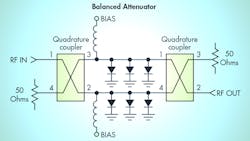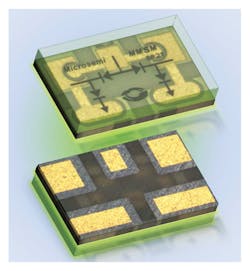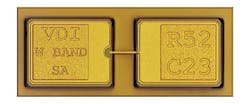Count on Diodes to Drive Performance
This file type includes high resolution graphics and schematics when applicable.
Diodes play an important role in RF/microwave applications, as they are used to design a wide range of components. They enable various functionalities to be achieved, such as frequency conversion, power-level monitoring, amplitude control, and many others. Diode types that are commonly used to design RF/microwave components include PIN, Schottky, varactor, and step-recovery. The actual components that can be designed with these devices include switches, attenuators, limiters, detectors, mixers, and more. Such components are obviously required to enable systems, thus demonstrating the significant role that diodes play in high-frequency applications.
Packaging Options
Diodes for high-frequency applications are available in various packaging options. These can include plastic surface-mount-technology (SMT) packages, ceramic packages, unpackaged chips, and beam-lead devices. Plastic SMT diodes offer a generally inexpensive option, making them suitable for low-cost, high-volume applications. However, plastic SMT packages suffer from parasitic reactances, which limit their frequency capability.
RF/microwave diodes are also available in ceramic packages; these have lower parasitic reactances than plastic SMT packages. In addition, their hermetic sealing can protect the die from environmental contaminants. However, ceramic packages are more costly in comparison to plastic SMT packages.
Diodes can also be purchased as unpackaged chips. These eliminate the parasitic reactances associated with a package, enabling them to be used with higher-frequency applications. Obviously, diode chips require die-attach and wire-bonding assembly capabilities. Flip-chip diodes, however, eliminate the need for wire-bonding, as these devices can be soldered or epoxied directly to a printed-circuit board (PCB).
Beam-lead diodes provide another option for higher-frequency applications. Their metal beams can be attached to a PCB by a bonding technique (e.g., thermocompression bonding). They also can be attached with conductive epoxy. Thus, beam-lead devices remove the need to perform wire-bonding.
PIN Diodes and their Applications
In basic terms, a PIN diode is a device that is essentially a variable resistor at RF/microwave frequencies. The resistance value is determined by the diode’s forward-biased DC current. This characteristic enables PIN diodes to be utilized to build components like switches and attenuators.
Switches, for example, are commonly designed with PIN diodes. Various topologies can be implemented when designing a PIN diode-based switch. Insertion loss, isolation, and switching speed are a few of the parameters that determine the performance of these components.
PIN diodes intended for switching applications are available from various suppliers. MACOM Technology Solutions (www.macom.com), for example, offers a large selection of PIN diodes. The company provides silicon, gallium-arsenide (GaAs), and aluminum-gallium-arsenide (AlGaAs) PIN diodes in various packaging options.
In addition to discrete PIN diodes, MACOM also offers actual switches that incorporate multiple PIN diodes into a single chip. The company is utilizing its heterolithic-microwave-integrated-circuit (HMIC) process to fabricate these components. Three new products were recently introduced that were fabricated with this process: the MASW-002103-1363, MASW-003103-1364, and MASW-004103-1365.
“Our new PIN diode switches utilize our patented HMIC process, which enables low loss and high isolation through low millimeter-wave frequencies,” says Paul Wade, product manager at MACOM. “As such, these monolithic, rugged devices are ideally suited for use in broadband, low-to-moderate-signal switch applications.”
Microsemi also offers PIN diode-based switching solutions. In addition to its selection of discrete PIN diodes, the company recently introduced the MPS4101-012S and MPS4102-013S single-pole, single-throw (SPST) switches. These PIN diode-based devices are single-chip, silicon-monolithic, series-shunt elements that operate from 50 MHz to 40 GHz. Microsemi also recently announced the MPS2R10-606, which is a high-power, monolithic-microwave-surface-mount (MMSM) single-pole, double-throw (SP2T) switch (Fig. 1). This PIN-diode-based switch covers 0.1 to 1.0 GHz. It can also handle as much as 100 W of continuous-wave (CW) input power.
In addition to switches, PIN diodes (as stated earlier) are used to design other components like attenuators, limiters, and phase shifters. Like their switch counterparts, PIN-diode-based attenuators can be implemented in various topologies. One often used implementation is the balanced attenuator, as this approach has the benefit of impedance matching across all levels of attenuation (Fig. 2). This configuration also allows higher power handling capability to be achieved. Skyworks, for example, offers a selection of PIN diode-based attenuators.
Limiters are intended to protect components from damage due to high-power signals. For instance, limiters are often used to protect the low-noise amplifier (LNA) in a receiver. PIN diodes are commonly used to create diode limiters. A diode limiter can be implemented by shunting a PIN diode to ground.
A selection of limiter diodes is offered by Skyworks. In addition, the company offers the SKY16602-632LF and SKY16601-555LF limiter modules. These modules are comprised of integrated PIN limiter diodes and DC blocking capacitors. The SKY16602-632LF spans 200 MHz to 4 GHz, while the SKY16601-555LF spans 500 MHz to 6 GHz. Both components are offered in SMT packages.
When searching for connectorized PIN-diode-based components, customers can choose from a range of suppliers. One such supplier, Herotek, offers PIN-diode-based switches and limiters. The company’s limiters offer performance capability to 40 GHz. These limiters are also offered with various levels of power-handling capability. In addition, Herotek offers a selection of PIN diode-based switches that span 500 MHz to 18 GHz.
PIN-diode-based attenuators, switches, and phase shifters are also offered by Waveline. These components provide performance capability to 20 GHz. Customers can request custom designs to meet specific requirements, as well.
Schottky Diodes, Detectors, and Sensors
A Schottky diode is another device commonly used to design RF/microwave components like detectors and mixers. They are created from a contact between a metal and a semiconductor. The metal is typically sputtered or evaporated onto the semiconductor’s surface, thus forming the Schottky diode junction. Both silicon and GaAs Schottky diodes are available from numerous suppliers.
Detectors are typically employed with Schottky diodes. The diode rectifies the RF input signal, thereby producing an output that is proportional to the magnitude of the input signal. Detectors are often used for power monitoring, radar equipment, lab testing, and more.
One supplier of Schottky diodes is Avago Technologies. Its devices are offered in a variety of packaging options and configurations. For example, customers can purchase diodes in configurations that include single diodes, ring-quads, bridge-quads, and several others. The company’s plastic SMT diodes are well suited for low-cost, high-volume commercial and consumer applications.
RF Schottky peak detectors are provided by Linear Technology. These detectors combine a temperature-compensated Schottky diode and buffer amplifier in a single package. The RF input signal is peak-detected by an on-chip Schottky diode. The detected voltage is then buffered and supplied to the output pin. As an example, the LTC5564 detector offers performance capability to 15 GHz. It operates with input power levels ranging from -24 to +16 dBm.
One company known for developing millimeter-wave and terahertz (THz) products is Virginia Diodes, Inc. (VDI). VDI offers GaAs Schottky diodes for W-band applications, enabling the realization of detectors and mixers in this frequency range (Fig. 3). These diodes are available as either a single device or as multiple devices arranged in series, anti-series, or anti-parallel configurations. Plus, the company offers simulation models for these diodes that can be obtained from Modelithics’ website.
Another supplier of diode detectors is Krytar. The company’s zero-bias Schottky detectors cover frequencies ranging from 10 MHz to 40 GHz. These detectors are intended for a wide range of applications: power measurements, system monitoring, and pulsed RF measurements in ultra-broadband and millimeter-wave applications, to name a few. Krytar offers these products with various connector options.
Power measurements have traditionally been achieved by means of a power meter along with a power sensor. The diode-based power sensor is one type of power sensor, as it utilizes diodes to directly convert AC to DC. The DC voltage is measured by the power meter and scaled to produce a power measurement reading. Krytar offers a selection of diode-based power sensors to satisfy power measurement requirements as well. The company’s 9500A-series power sensors offer measurement capability to 40 GHz.
Power sensors are also offered by Boonton (part of the Wireless Telecom Group). The company provides diode sensors that utilize balanced diode detectors. Several of these dual-diode sensors have a dynamic range that spans from -70 to +20 dBm. Customers can select from a variety of frequency ranges, including models that can operate to 40 GHz.
More Devices: Varactors and Step-Recovery Diodes
Varactor diodes are often incorporated into the design of components like oscillators, filters, and phase shifters. These devices behave as voltage-varying capacitors, with the capacitance changing as the bias voltage applied to the varactor is varied. This property enables these devices to be utilized as tuning elements in RF/microwave circuits. For instance, varactors are often implemented as tuning elements in voltage-controlled oscillators (VCOs).
Varactor diodes can be classified as abrupt or hyperabrupt. Abrupt varactors have a higher quality-factor (Q) than hyperabrupt versions. However, hyperabrupt varactors provide better linearity. Varactors are offered by many of the companies already mentioned, such as Skyworks, MACOM, and Microsemi.
Step-recovery diodes (SRDs), also known as snap-varactor diodes, can be used to build frequency multipliers and comb generators. Comb generators produce a set of harmonic outputs when driven by an input signal. The spacing between these harmonics is equal to the frequency of the input signal.
SRDs store charge as they are driven into forward conductance by the positive voltage of an input sinusoidal signal. This charge is extracted when the signal reverses polarity, thereby generating a reverse current. When the charge has been exhausted, the reverse current abruptly ceases. This abrupt change, or “snap-off,” produces a pulse that is rich in harmonics, enabling SRDs to be used to create frequency multipliers.
Various suppliers are currently offering SRDs. One such supplier is API Technologies, which offers a variety of devices. “API’s current capability allows us to offer silicon-based step-recovery diodes. These snap-varactor diodes find application in high-efficiency multipliers, up/down converters, comb generators, and in a variety of high-reliability, science-based space applications,” says David Sims, product manager at API Technologies. “These devices can provide a cleaner output signal in comparison to monolithic-microwave-integrated-circuit (MMIC) designs. They do, however, require additional supporting components to deliver optimized performance in a system.”
Beyond the examples listed here, many more options—from numerous suppliers—are available via the four types of diodes for RF/microwave applications, as well as diode-based components. Such availability allows today’s customers to select the device or component that is best suited for their requirements. Some diode suppliers also provide a collection of application notes on their respective websites. These documents offer a vast amount on information on the topic of RF/microwave diodes for those who wish to learn more. Skyworks has even published an "RF Diode Design Guide," which provides an overview of the company’s diode products along with a great deal of practical information.
This file type includes high resolution graphics and schematics when applicable.




